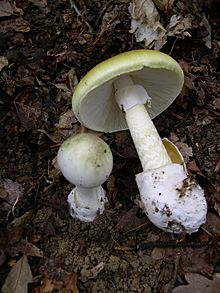Amanita facts for kids
Quick facts for kids Amanita |
|
|---|---|
 |
|
| A. muscaria | |
| Scientific classification | |
| Kingdom: | |
| Phylum: | |
| Class: | |
| Family: |
Amanitaceae
|
| Genus: |
Amanita
|
The Amanita group is a genus (a type of family) of mushrooms. Many of these mushrooms are known for being very poisonous. You can find Amanita mushrooms all over the world.
This group of mushrooms causes about 95% of all deaths from mushroom poisoning. The "death cap" mushroom alone is responsible for about half of these deaths. The most dangerous poisons in these mushrooms are called amanitins. There are at least eight different types of amanitins.
Contents
Fly Agaric: A Famous Red Mushroom
Amanita muscaria, often called the fly agaric, is a well-known mushroom. It has a bright red cap with white spots. This mushroom is known to affect the mind.
It got its name "fly agaric" because people used to mix it with milk to kill houseflies. Flies were attracted to the sweet milk. When they drank it, they would get sick from the mushroom's effects.
Death Cap: The Most Dangerous Mushroom
Amanita phalloides, known as the death cap, is an extremely poisonous fungus. It is one of the most deadly mushrooms in the Amanita group. This mushroom is common across Europe.
The death cap grows near many types of broadleaf trees like oak and chestnut. Sometimes, it has been accidentally brought to new places when these trees were planted there. The mushrooms appear in summer and autumn. They usually have a greenish cap, a white stem (stipe), and white gills underneath the cap.
Eating just one death cap mushroom can destroy a person's liver and cause death. There is no known antidote (medicine to stop the poison).
How Amanita Toxins Work
The main way Amanita toxins cause harm is by stopping a very important enzyme called RNA polymerase II. This enzyme is vital for making messenger RNA (mRNA) inside cells.
Without mRNA, cells cannot make the proteins they need to work properly. This means the cell's metabolism (how it uses energy) stops, and the cell dies.
The liver is the main organ that gets hurt by these toxins. This is because the liver is the first organ the toxins reach after being absorbed from the gastrointestinal tract (stomach and intestines). Other organs, like the kidneys, can also be damaged. Interestingly, the RNA polymerase inside the Amanita phalloides mushroom itself is not affected by its own toxins, so the mushroom does not poison itself.
Images for kids
-
A. caesarea (edible)
See also
 In Spanish: Amanita para niños
In Spanish: Amanita para niños





